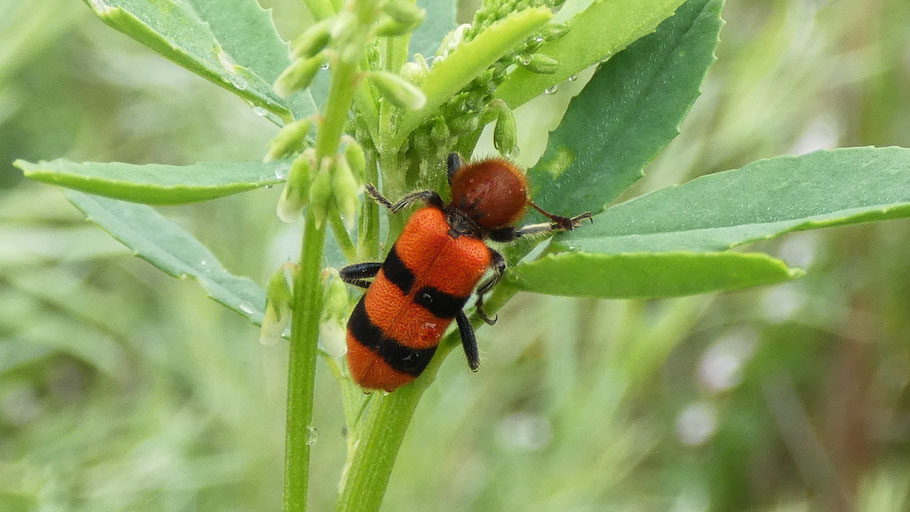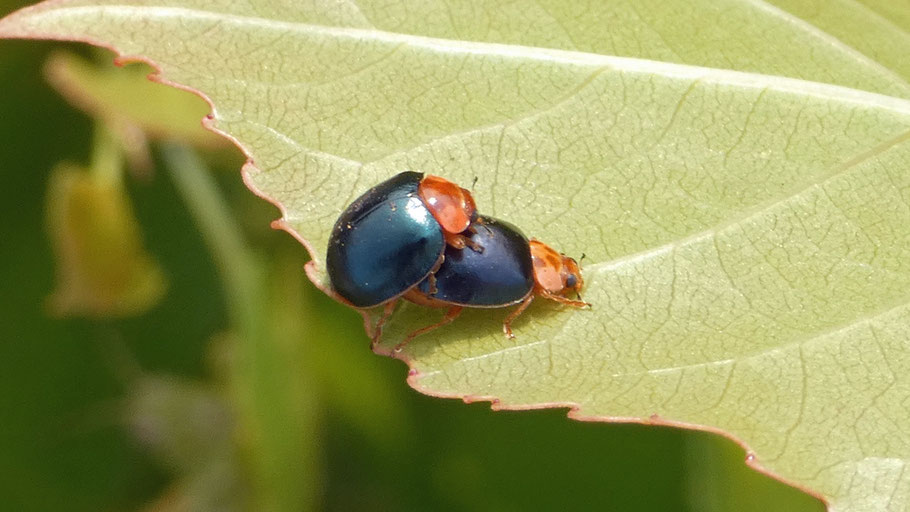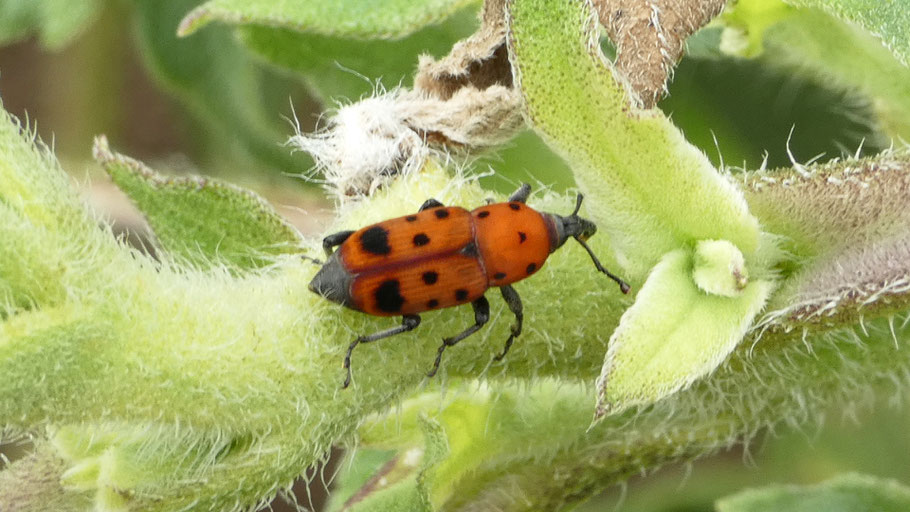A Few New Mexico Beetles
(Coleoptera)
J.B.S. Haldane once remarked that the Creator must have an inordinate fondness for beetles, since there are so many species of them. (Or words to that effect.) I feel the opposite way; they fall under my phobia of all things bug-like. But it's fascinating, if creepy, to have encountered so many different beetles in my tiny patch of the planet. They're shown alphabetically by family, genus, and species. Hover over images with your cursor to control them.
Buprestidae (Metallic Wood-boring Beetles): Acmaeodera bowditchi
This species lacks a unique common name, but one common name for the genus is "spotted flower bupestrid."
Cantharidae: Colorado Soldier Beetle (Chauliognathus basalis)
Cantharidae: Soldier Beetle (Chauliognathus lewisi)
Carabidae: Caterpillar Hunter Beetle (Calosoma)

As I was walking through the Bosque, this one dropped out of the canopy.
Carabidae: Boreal Long-Lipped Tiger Beetle (Cicindela longilabris)
Cerambycidae: Batyle ignicollis
The iNaturalist app provides a common name, fire-necked longhorn beetle, for this species, but apparently that name isn't in widespread use. Ignicollis does mean "fire-necked."
Cerambycidae: Yellow Velvet Beetle? Lepturobosca cf. chrysocoma)
Also known as a golden-haired flower longhorn beetle. Assuming the species ID is correct. If it isn't, the other option is Lepturobosca nigrolineata.
Cerambycidae: White-Spotted Sawyer Beetle (Monochamus scutellatus)
My ID to the species level is based on the tiny white triangle (scutellum) where the bases of the wing covers meet. It's a female because it's spotted rather than all black, and because its antennae are roughly the same length of the body.
Cerambycidae: Milkweed Longhorn Beetle (Tetraopes annulatus)
Although I'm not a great fan of bug-like things, this has to be my favorite beetle.
Cerambycidae: Spotted Tylosis Beetle (Tylosis maculatus)
The larvae of this beetle feed on the dead roots of globe mallow plants, and the adults hang out topside. The family as a whole is known as longhorn beetles.
Chrysomelidae: Flea Beetle (Altica)
When I walked by, these beetles had congregated by the hundreds on Apache plume bushes—and only on bushes of that species, despite there being other options.
Chrysomelidae: Dogbane Leaf Beetle (Chrysochus auratus)
This beetle got its name because it eats dogbane (Apocynum) leaves. Dogbane leaf beetles also mate on the leaves. Afterwards the females deposit eggs on the undersides of the leaves, in piles of their own fecal material. When the eggs hatch, the larvae drop to the ground and work their way down to the dogbane roots, which becomes their food source until it's time to pupate.
Chrysomelidae: Cottonwood Leaf Beetle (Chrysomela scripta)
When you see obvious chewing on cottonwood leaves, look for this beetle. It hangs out on cottonwoods as larvae and as adults. Between those two stages the pupae dangle from branches in large numbers. My thanks to David Lightfoot for identifying the larval and pupal stages of this leaf-chomping beetle.
Chrysomelidae: Spotted Cucumber Beetle (Diabrotica undecimpunctata)
Chrysomelidae: Disonycha politula
These tiny beetles spend their adults lives munching on a single host plant, pigweed (Amaranthus palmeri).
Chrysomelidae: Three-Lined Potato Beetle (Lema daturaphila)
Three-Lined Potato Beetles resemble, so are confused with, Striped Cucumber Beetles. Both have three black stripes with yellow between them, but the Three-Lined Potato Beetle has a narrower thorax that is brown or reddish with spots. Also, the head isn't black.
Chrysomelidae: California Willow Beetle? (Plagiodera californica?)
On an a cool September morning I found these beetles swarming on willow plants next to the Rio Grande. The Imported Willow Leaf Beetle (Plagiodera versicolora) is supposedly confined to the eastern half of the country, so I suspect this bunch of being the California Willow Beetle. However, I was unable to find satisfactory information on the range of either species.
Chrysomelidae: Rubber Rabbitbrush Beetle (Trirhabda nitidicollis)
The larvae and adults of this species feed on rubber rabbitbrush (Ericameria nauseosa), but also on at least three other species in the aster family.
Cleridae, Checkered Beetles: Trichodes bibalteatus

Cleridae: Ornate Checkered Beetle: Trichodes ornatus
My thanks to Bruce Tilden (via BugGuide) for the ID. These beetles can also be red and black.
Coccinellidae: LeConte's Giant Lady Beetle (Anatis lecontei)
Coccinellidae: Seven-Spotted Laydbug (Coccinella septempunctata)
Coccinellidae: Asian Lady Beetle (Harmonia axyridis)
These lady beetles were introduced from Asia to provide pest control. They can be pests themselves, as they sometimes overwinter in homes and smell bad if squashed.
Coccinellidae: Convergent Lady Beetle (Hippodamia convergens)
The number of spots on these lady beetles can vary. To make your ID, look for the slanting white "eyebrows" on the pronotum (the section just behind the head).
As one of the photos shows, convergent lady beetles form large aggregates during part of their life cycle. I've repeatedly found these aggregates on mountain peaks in warm months.
Coccinellidae: V-Marked Lady Beetle (Neoharmonia venusta ampla)

V-marked lady beetles have varied markings. This black (or very dark blue) and orange variety, the ampla subspecies, occurs from Arizona east to Texas.
Curculionidae: Ironweed Curculio (Rhodobaenus tredecimpunctatus)

What's not obvious in this photo is the downward-curving snout.
Erotylidae: Blue Fungus Beetle (Cypherotylus californicus)
The Erotylidae as a whole are known as pleasing fungus beetles, so this one's sometimes called the blue pleasing fungus beetle.
Lycidae (Net-Winged Beetles): Lycus arizonensis
Meloidae: Desert Spider Beetle (Cysteodemus wislizeni)
Meloidae: Blister Beetle (Megetra)

To see my YouTube video of this little critter, click here.
Meloidae: Nemognatha Blister Beetle (Nemognatha)
This beetle uses very long mouth parts to suck nectar. Nemognatha adults are drawn to aster family flowers as a food source; the females lay their eggs there. The young larvae attach themselves to solitary bees and on reaching their nest, eat the bee's stored food, its offspring, or both before pupating. I feel bad for the bees.
Mordellidae (Tumbling Flower Beetles): Mordella
Scarabaeidae: Figeater Beetle (Cotinis mutabilis)

These large June bugs resembles the Green June Bug, Cotinis nitida. That species supposedly ranges no farther west than Texas, but I have seen online assignments of New Mexico June bugs to that species. My reluctant ID is Figeater Beetle. Reluctant because of the dorsal coloration: a green central area that's so dull it can look black, flanked by broad areas of dull yellowish brown to brown. These bugs do have the dark femurs and uniformly colored pygidia (you'll have to look that one up) often used to characterize C. mutabilis. I threw in the thumbnail to show that while the end of each antenna often looks club-shaped, it consists of three "tines."
Tenebrionidae: Desert Stink Beetle (Eleodes)
Everyone who has walked around in the high desert has seen this one! It's popularly known as a "stink bug." If it raises its butt, that means that it feels threatened and ready to spray some stinky stuff.





















































































































































































